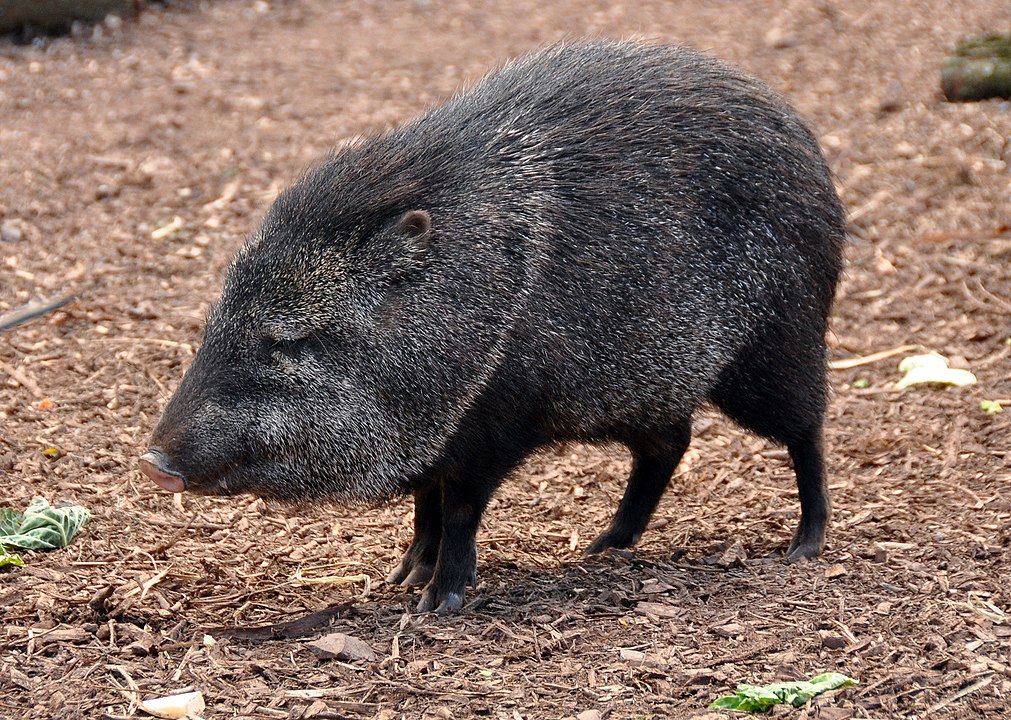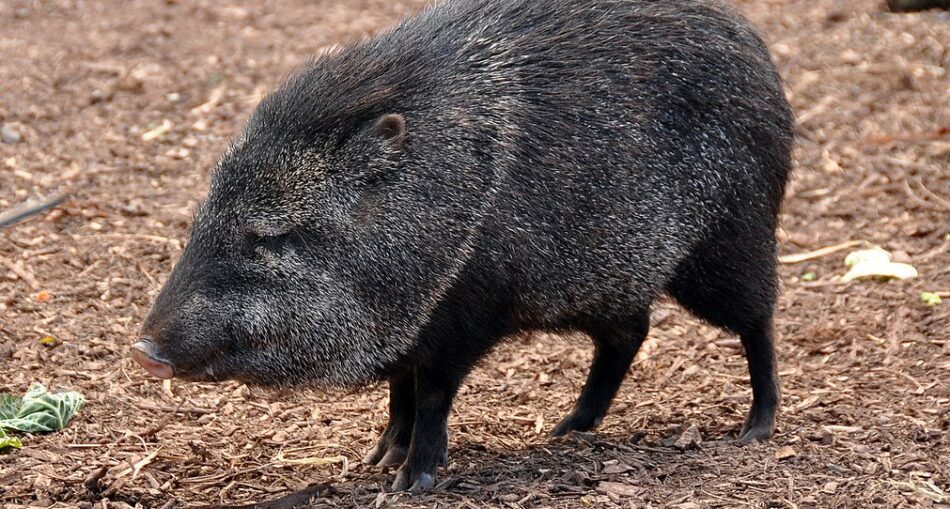The Collared Peccary is equivalent to the New World swine and is native to Guyana. In fact, it is one of the only two species of peccaries native to the country. Both the White Lipped-Peccary and the Collared Peccary can be found in the Iwokrama Rainforest. While the Collared Peccary is a relative of the pig and is usually referred to as one, it belongs to a wholly different family than true pigs. The scientific name of the Collared Peccary is Pecari tajacu but is known by several common names. The Collared Peccary is also known as the musk hog, skunk pig, saíno, or báquiro Javelina and quench locally in Trinidad. In the Makushi language of Guyana’s Macushi people, the animal is called the praka, paraka while in Trinidad, it is called the quench.

The Collared Peccary – Photo
Features Of The Collared Peccary
- Colour – The fur of the Collared Peccary is typically dark grey or a grey-brown colour with a light collar extending from under its neck to the top of its neck. Its fur is coarse and often hides its tail as a result.
- Body Structure – Collared Peccaries are stocky animals with slender legs. Its small straight tusks, which point downwards when the mammal is standing.
- Weight & Length – A Collared Peccary weighs about thirty-five to sixty pounds (35-60). It has a height of about twenty to twenty-four (20-24) inches and a length of three to four feet(3-4).
Interesting Tip
- The dental formula of the Collared Peccary is 2/3,1/1,3/3,3/3.
Scientific Name Of The Collared Peccary
- Domain: Eukaryota
- Kingdom: Animalia
- Phylum: Chordata
- Class: Mammalia
- Order: Artiodactyla
- Family: Tayassuidae
- Genus: Pecari
- Species: P. tajacu
Habitat Of The Collared Peccary
Collared Peccaries are native to parts of North America, Central and South America in countries like Guyana and Trinidad. This widespread animal can be found in most parts of the tropical and subtropical Americas. The habitat of the Collared Peccary ranges from tropical, subtropical or flooded grasslands, and savannahs, and shrublands, and dry broadleaf forests, and even deserts. In some cases, it can be found in some agricultural land.
Interesting Tip
- They were reintroduced to Uruguay in 2017 after being extinct in the country for over one hundred (100) years.
Diet Of The Collared Peccary
Collared peccaries are omnivorous. They normally feed on cactus, mesquite beans, fruits, roots, tubers, palm nuts, grasses, invertebrates, and small vertebrates. In areas inhabited by humans, they also consume cultivated crops and ornamental plants, such as tulip bulbs. The Collared Peccary is omnivorous, meaning they consume both animals and plants. They feed on fruits and root, grasses, nuts, tulip bulbs and even cactus. In addition, they eat small vertebrates and invertebrates.
Reproduction Of The Collared Peccary
The breeding season of the Collared Peccary depends on the climate and occur throughout the year. Litter consists about one to three young (1-3) but can be up to four (4), born after a gestation period of one hundred and forty-one to one hundred fifty-one (141-151 days). They are typically weaned at two to three months. While the females reach sexual maturity in eight to fourteen (8-14) months while their male counterparts reach this an at eleven (11) months. Collared Peccaries has lifespan of up to twenty-four (24) years in captivity.
Ten Facts About The Collared Peccary
- The Collared Peccary is prey upon mainly by wild cats like jaguars cougars, bobcats and as well as coyotes and some wolves.
- Peccaries produce sounds which include, grunts, barks and purrs. When the animal gets scared or unnerved it makes a series of sharp whoofs.
- The Collared Peccary is typically a diurnal creature but may change their sleep schedule to become nocturnal if they are being hunted.
- Collared Peccaries live in groups of six to nine (6-9) members but can reach up to fifty (50).
- They often make burrows in the roots of trees as their sleeping places.
- The mammal typically ignores a human but if they feel threatened, they may attack.
- Tusks are used for defence.
- Only the dominant males breed in the herds; the subordinate males are not allowed.
- The pregnant females will retreat from the group because their newborn may be eaten by other members of the herd and rejoin after one day after giving birth.
- The older female siblings of the newborn are the only ones allowed near the newborn except the mother since they sometimes serve as nursemaids.
The Collared Peccary In Guyana
While the Collared Peccary resembles the Old World pigs, they are not considered the same but a different species of New World mammals. Native to Guyana you can find peccaries in tropical, forests parts of the country, like the Iwokrama Rainforest where they are a common thing among other local wildlife.
Article References
- https://en.wikipedia.org/wiki/Collared_peccary#:~:text=The%20collared%20peccary%20(Pecari%20tajacu,known%20as%20the%20musk%20hog.
- https://www.stabroeknews.com/2012/01/15/features/collared-peccary/#:~:text=The%20Iwokrama%20Rain%20Forest%20is,in%20the%20heart%20of%20Guyana.&text=In%20Guyana%2C%20there%20are%202,peccary%20and%20the%20collared%20peccary.
- https://a-z-animals.com/animals/collared-peccary/
- https://iwokrama.org/mammals/guides/hoof0.html#:~:text=Mammals%20of%20Iwokrama,such%20as%20peccaries%20and%20deer.&text=Description%3A%20This%20is%20the%20largest%20mammal%20in%20Iwokrama.
- https://animaldiversity.org/accounts/Pecari_tajacu/







